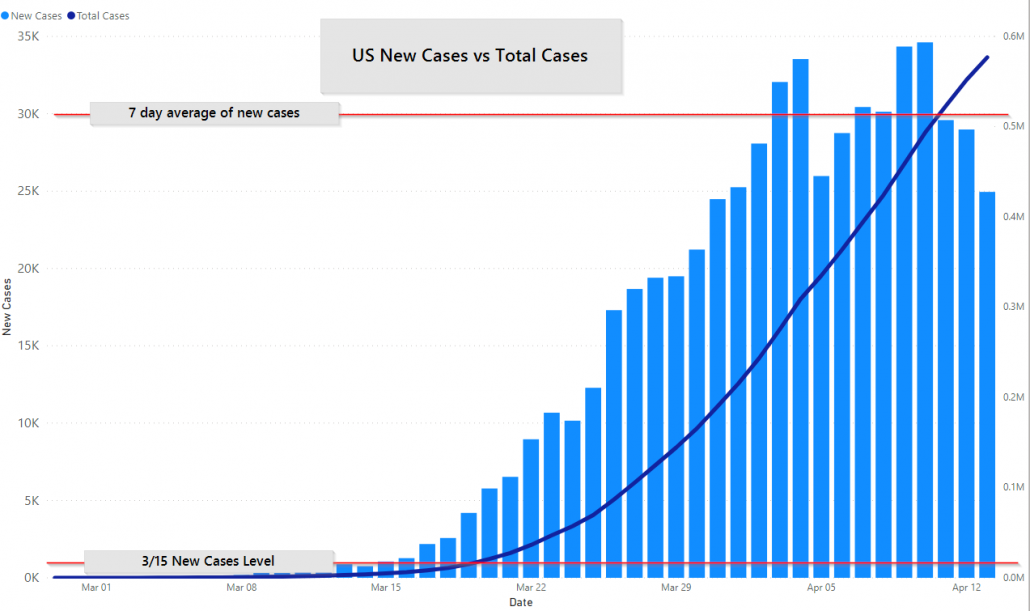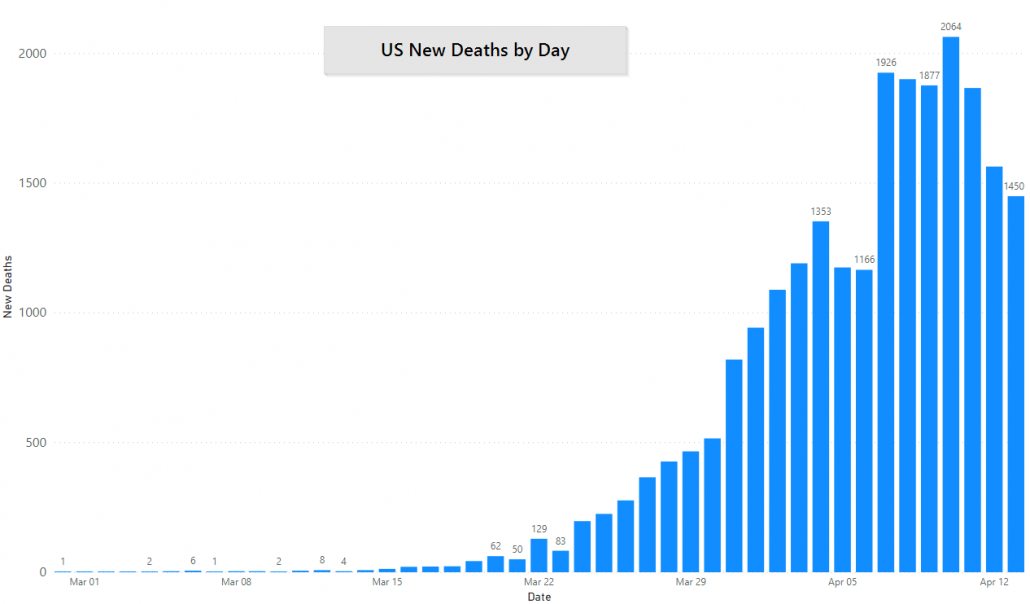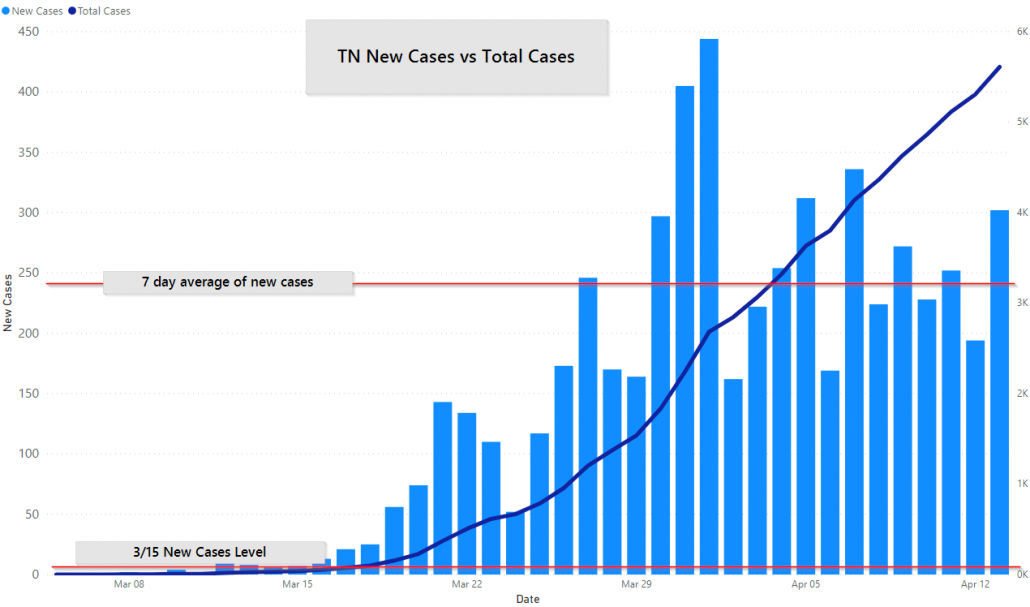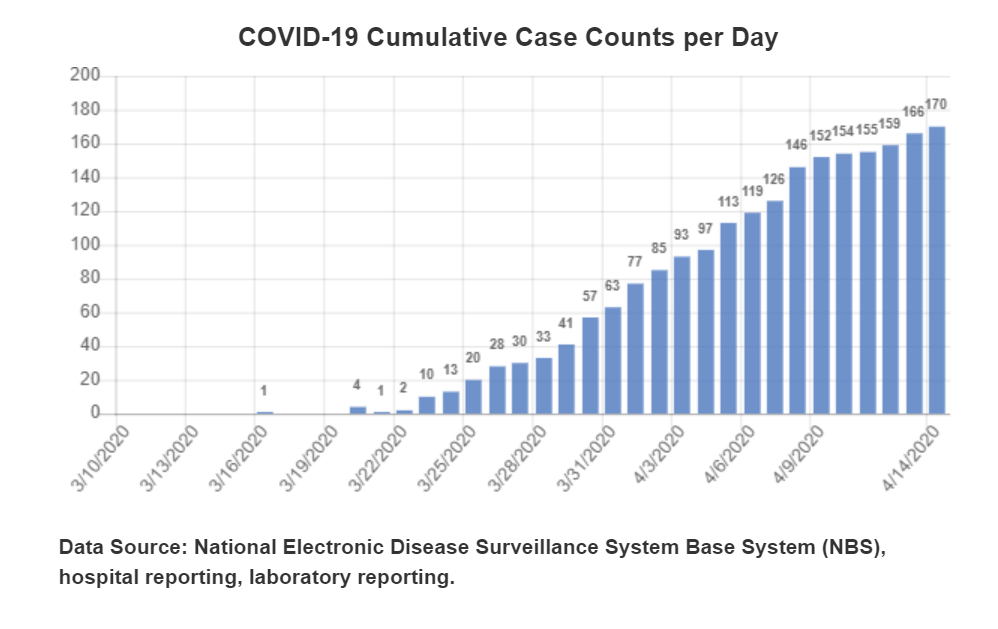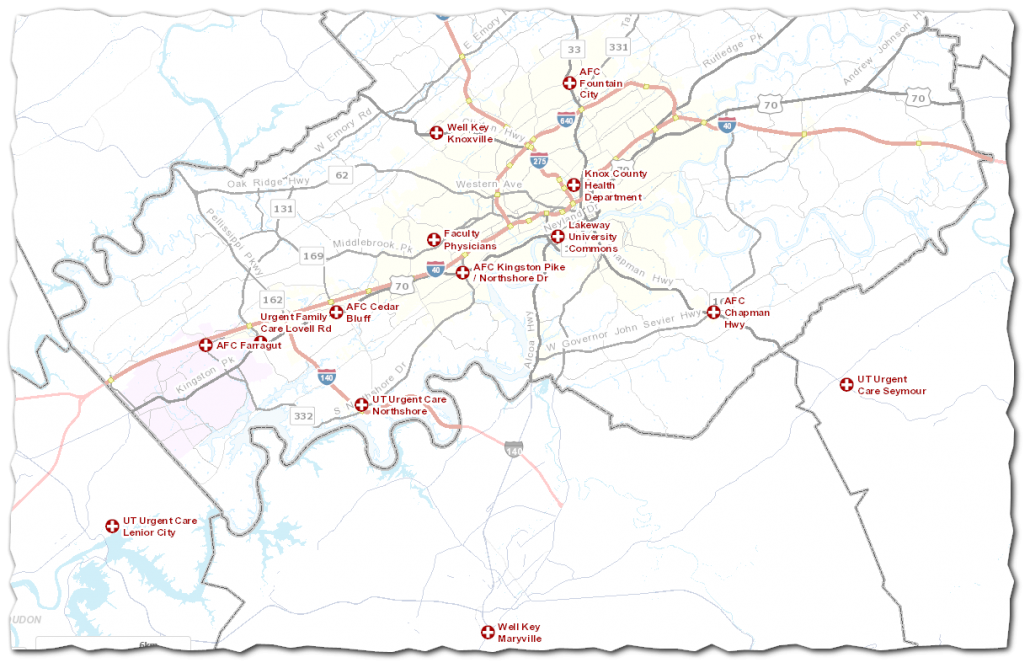Today we’re going to briefly hit the numbers at the national, state, regional and county level, hit a couple of news items and then spend a little bit of time talking economics.
Numbers
Nationally, we are looking at a fourth straight day of a decline in new cases. Today is not shown yet but it is looking to be another day with fewer new cases than yesterday. We have horizontal lines showing the 7-day average for new cases and the level as of March 15th, a date we’ve chosen because it seems to be about the time the public realized that COVID-19 was going to be an issue.
New US deaths is down three of the last four days but probably up today, with over 1800 new deaths reported so far. This is, of course, the metric that matters the most: we’re more concerned with the number of people dying from COVID-19 than who are sick. Deaths lag cases. Also, keep in mind that (1) we need more than 4 days of data to call it a real trend either way, and (2) we’re really looking at both new deaths and new cases together to determine which way things are going.
New Jersey is up to 65,000 cases, making up over 10% of the US total.
Looking at just Tennessee the data shows a downward trend over the whole month but the last week is about even:
We’ll note that the data we have above is substantially different than what the TN Department of Health shows, however, our new case data totals are about the same as what the state is reporting, we conclude that the state reports new cases on a lag.
Tennessee has 10 long term living facilities that report at least two cases between staff and residents. Three in Franklin, two in Gallatin, and one in each Nashville, Knoxville (Williamsburg Villas), Lafayette, Cookeville and Memphis.
The Knoxville area continues to see a slow growth in cases:
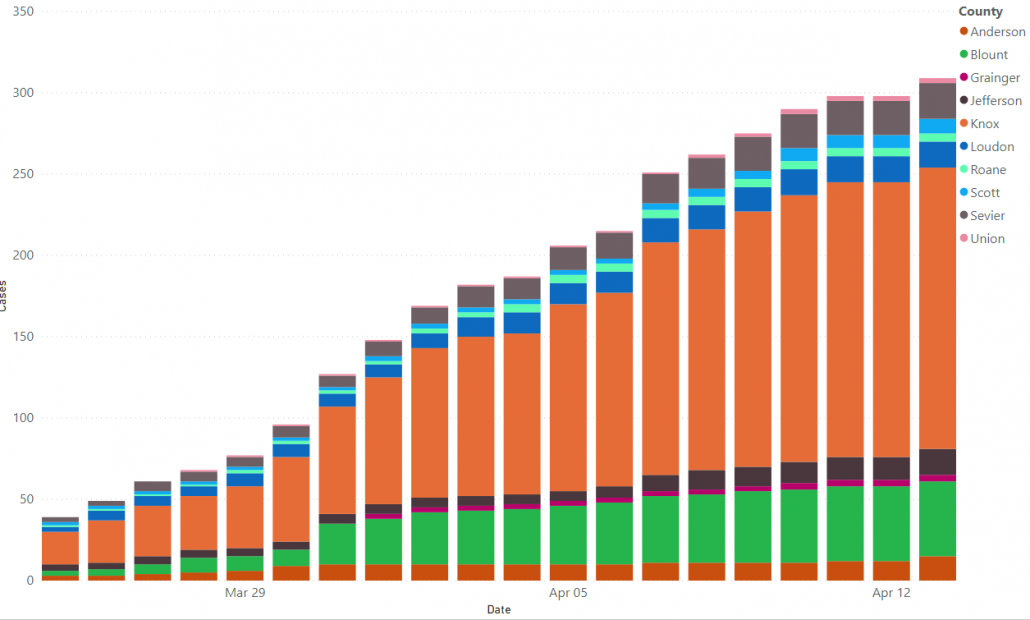
Knox County is still the bulk of the area cases, and you can see that growth in new cases hasn’t changed notably since April 9th:
Data from Unacast and Google show social distancing to be pretty much leveled off in the state, including Knox County. It will be interesting to see if new cases per day continue to drop over the month if social distancing stays at its current level. The most interesting question, to us, is how will people react come May 1st if new cases are constant, regardless of plans to re-open?
Neither the county nor the state have briefings online right now (5 PM EST). It’s not clear why.
You can find a map of places to get tested for COVID-19 here.
Knox County released a phased in plan for restarting the economy. The county health department has called it a draft, stating, “The draft proposal was created by Mayor Jacobs in direct response to a request from Governor Lee who asked city and county mayors from across the state for their thoughts regarding a phased re-opening.”
News
We personally know people that have the stimulus hitting their accounts. No word on actual PPP funds hitting accounts, other than some owners who have received fraction and believe that their bank simply advanced the money. Multiple states are announcing their plans to re-open, starting with California. However, timelines are not part of the plans yet.
Economics
JP Morgan is predicting, “a fairly severe recession,” unemployment claims have topped 13 million in three weeks with more expected, the IMF has said that they expect a recession far worse than the 2008 financial crisis.
So, is the economic world ending?
First, no one knows. There isn’t a playbook for turning the world economy off and back on again. The closest thing to COVID-19 economic data we have is China, a country still officially communist. The Federal Reserve has made a good case that this recession will look more like one that follows an awful hurricane than a typical recession.
It is an analysis that we agree with, to date. First, a typical recession comes slowly, it often isn’t clear in the moment what is driving it and there are underlying economic problems that took years to build up and take years to fix. The COVID-19 recession came suddenly and with clarity. The massive job losses you see are businesses acting quickly to preserve themselves and future job capacity. Your local retailer or restaurant may have laid off staff today but if they still exist in July (some) jobs can return.
In a typical recession, businesses all grab for the money at once to preserve their capital. Today, businesses are acutely aware that if everyone acts that way that their own customer base will implode, with their business along with it. Practically: if Wells Fargo didn’t let people defer mortgages they would have a bankruptcy problem in 90 days that far outweighs the cost of mortgage deferments. The same is true with rent, credit cards, etc. We aren’t saying that no one will act this way, but broadly, industry understands that dropping the hammer will cost the one who dropped it as much as the one it lands on.
The federal government has also reacted with breathtaking speed (for the federal government). The Paycheck Protection Program, the stimulus checks and several other actions by the federal reserve have been reactions that in the past would have been done in months or years, not weeks.
All of this is to say that the coming recession looks a lot, lot different than anything else we’ve gone through in the modern economy. It is entirely possible that things will turn up much faster than other recessions.
It is also true that this will cut deeper in many areas, and a “return” is measured in months and not weeks.
The President of the Federal Reserve Bank of Atalanta said today that the recovery could begin in the third quarter, and we think that is the optimistic view.
Unemployment will get worse before it gets better, and will only slowly get better. We could be at double digit unemployment for most, or all, of 2020. Hotels, restaurants, concerts, churches, retail, etc., cannot get back to normal until COVID-19 is virtually gone, and that is an 18-24 month horizon. It is likely that travel restrictions stay in place for months.
And we don’t have time today to touch on industries like airlines, tourism, cruises, amusement parks, etc.
It’s going to be a rough ride for a while.
As your author and business owner, I am still supremely confident that we will get through this. The recessions that stay with us have been ones that we made, the storms that have come upon us have passed, and we’ve recovered from.
How Your Author is Adjusting
Let me get personal with you for a little bit. I assume that our family’s personal income will be down by at least 25% for a while, maybe this whole year. The stimulus will help us more than most (we have 8 children). We’ve managed to cut personal expenses by 25% and I believe we can keep them cut at that level for the rest of 2020.
Any cash that we are able to save and keep on hand, we are. It’s possible that some of it, maybe a lot of it, will go back into the business.
Instead of going out, my wife and I have spent the last several Fridays perfecting our stir-frying together.
Fun and nice groceries are mostly out right now, we buy essentials. We ate a lot of rice and beans before, now we eat more. We’ve switched over our youngest baby to cloth diapers we already had.
I don’t know yet if my seven year old will return to gymnastics this year.
I’m spending a lot more time working than I was a month ago, not less.
And, finally, no one ever sets the thermostat more expensive than it needs to be.
And it’s all going to be alright. 2020 and 2021 are not going to look like what I had pictured and that is OK. We’ve created safe spots at work and at home for many and, Lord willing, will continue to grow those spaces to include more people.
Get In Touch
Need help thinking this through? Access to more data? Help getting your technology in order to handle what’s here and what’s coming? Contact us today.
Other
Thanks to those that have shared kind words or liked these posts. We’re doing out best to put out data-driven analysis, each one of these takes about 2 hours. It’s helpful to know that they are being read.
If you want copies of the Excel sheet and PowerBI Reports we use to put these together email us, info@jmaddington.com. Right now, our PowerBI combines data from JHU, NYT, COVID Tracking Project, IMHE and the TN Department of Health. Most sets are updated daily.
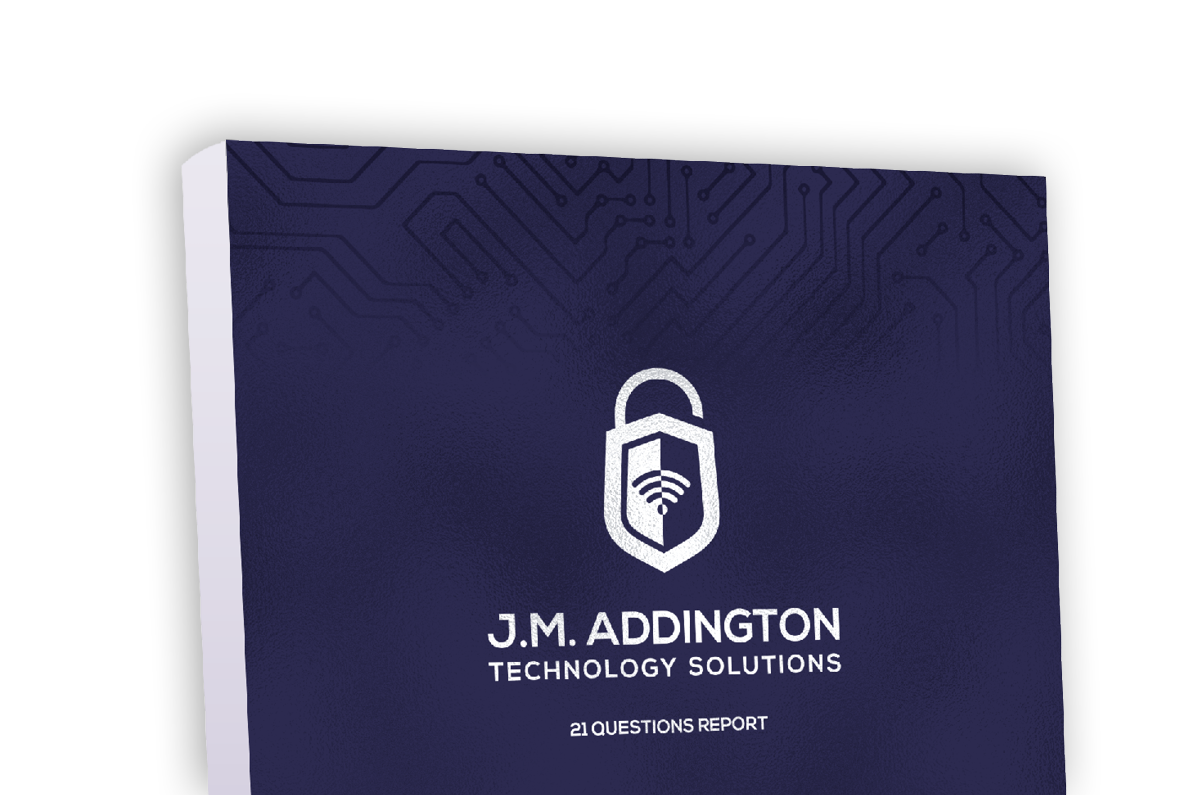
Download our Report!
Get your copy of What Every Business Owner Must Know About Hiring an Honest, Competent, Responsive, and Fairly-Priced Computer Consultant.

